#haired individual and only age into brown hair. it also depends on the skintone and eyes like if i saw someone with washed out brown
Explore tagged Tumblr posts
Text
every once in a while i see people absolutely confused over "brown" hair being called "blond" and i'm just like. wondering if it's a cultural difference or if people whose hair is blond (yellow) when they're kids-teens-young adults and then gradually darkens as they age have like... died out, or
#shrimp thoughts#both of my parents had light blonde hair as kids but i've only known them with this kinda washed out brown#and i had washed out golden hair as a kid but now it's noticeably darker (but i also dyed my hair a bit in high school-early years of uni#and i don't know just how much dying one's hair affects their natural color but. yeah)#and like. idk. imo when you're born with brown hair it's different from when spend the first 30 years of your life as an obvious blond#haired individual and only age into brown hair. it also depends on the skintone and eyes like if i saw someone with washed out brown#hair blue eyes and pale skin i'd say they're dark blond
5 notes
·
View notes
Text
Species Traits and Variants
The two human-descended species of Celantri have signature traits that easily differentiate them from one another, but they also display variance within their own species as a result of adapting to various climates. Though notable gene pools are listed, the variants are very intermixed on modern Celantri. Most individuals carry traits associated with multiple variants, even if one appears more dominant.
AWANI TRAITS
Skin - Shades of beige and brown. Similar to human skintones, but often a bit more greyed. Their blood is wine red.
Hair - Can be any color (usually on the muted side), but black is most common. Always a different color than frills. All Awani have hair on their head, armpits, and pubic area. Most have a tuft of fur on the chest. May or may not have body and facial hair depending on subtype and scale distribution. Some may have short, fine hair on the tail (see below).
Scales - Three scale types are most common - smooth, coarse, and fine. Smooth scales are rounded and evenly spaced. They are usually semitransparent. Coarse scales are opaque, diamond-shaped, and grow in clusters. Fine scales are very small, giving a gradient-like effect as they fade into the skin. Scales are most often the same color as frills, but not always.
Tail - Thick tails are better for storing fat and floating in the water, while thin tails are better for agility. The body of the tail may be bare (skin color), fully or partially scaled, or covered in a fine, velvety hair. Frills grow near the tip of the tail, and may continue upwards all the way to the base. A rare gene also exists that causes the end of the tail to grow spikes rather than frills. They can drop their tail under extreme stress, though this will lead to discomfort and balance problems afterwards. It will take anywhere from 6 months to a year to completely grow back.
Eyes - Iris/pupil shapes and colors vary widely - the evolutionary significance of this is unclear.
Hands/Feet - Awani have clawed fingers and toes, with the knuckles typically reinforced by thick scales. Heavy scaling on the hands is a fairly common trait, as are hard, stiff "fully clawed" toes. They often have durable pads on the underside of the feet, and, less commonly, on the palms of their hands. Some individuals may have 4 fingers or toes per appendage instead of 5.
Teeth - They may have any combination of sharp and flat teeth, but will always have at least one set of visible fangs. Some may have a full mouth of sharp teeth. Some fangs will continue to grow with age - older Awani are more likely to have teeth that stick out even while their mouth is closed
Ears - Ears come in various shapes and lengths, usually with one or two points to them. They may have frills surrouding them entirely, or only on the top or bottom.
Frills - As mentioned above, frills always grow around the ears and tail. They may also grow between extremities, on lower limbs, and/or the torso.
Whiskers - Awani have 1-3 sets of thick, flexible whiskers that grow between the mouth and the jawline, made of the same material as their frills. These whiskers allow them to sense changes in barometric pressure and wind currents. Individuals have varying whisker lengths and growth patterns. They can comfortably be trimmed down to a smaller base, but will always grow back to their full length.
VARIANT CLASSIFICATIONS
Primordial – The “original” Awani that the other variants later descended from. Typically pictured as heavily scaled with smooth scales, large fangs, long whiskers, and black hair and tails. Common in Kalibaru and Auvedaya.
Coastal – A variant most suited to living around the water. They have fine scales, very little body hair, more frills, and large, thick tails. Common in the Spiral Isles and Auvedaya.
Arid – Adapted to harsher desert conditions. They usually have coarse scales, longer ears, slitted pupils, and thin, flexible tails – they are the carriers of the spiked tail gene. Most likely to have 4 digit hands/feet. Common in Ishanyr.
Continental – Compared to the other variants, these Awani are better suited to colder conditions. They are prone to more body hair, short whiskers (but multiple pairs), coarse scales, fully sharp teeth, light hair, and short, thick tails. Common in Ishanyr.
GUNARI TRAITS
Skin - Dull tones of purple, blue, or red. Their blood is a deep indigo.
Hair - Can be any color, but never the same color as the antennae. They tend to have more body hair. There may be tufts of hair around the wrists, ankles and tail, and/or in or around the ears. How far up the appendage this thick tuft of hair grows depends on the variant.
Ears - Large folded ears. May stick out straight (the most common), swoop back, flop down, or even point upwards like a cat. Some are more rounded, while others are more pointed. The outer part of the ear is a different color, while the inner part matches the rest of their skin. Usually has only one point, but may have several. Ear size and range of movement vary. Those with more reactive ears will show their emotions more easily.
Antennae - Antennae come in various shapes and sizes. They may be fluffy, bare, or have a thin growth similar to an insect’s wing.
Markings - Some Gunari carry a recessive trait that causes them to have skin markings in the same color as their antennae - these may appear like freckles, splotches, or stripes.
Tails - The Gunari have long, thin tails topped with an appendage similar to their antennae. The shaft of the tail is the same color as their outer ears.
Hands/Feet - Rounded fingers and toes with nails but no claws. Their hands and feet have gecko-like properties that allow them to easily climb up vertical surfaces.
Eyes - Round iris/pupil, any color. Those that evolved the deepest underground may have full-colored eyes. All variants have some degree of night vision
Teeth - Flat teeth.
VARIANT CLASSIFICATIONS
Forest – The first group of Gunari to settle on the surface. They usually have long, fluffy antennae and small tufts of fur on the tail, wrists, and ankles. Their ears generally stick out straight with a pointed tip and are very reactive. They are the most likely to have skin markings, which may have served as a sort of camouflage. Common in North and South Florene and Ishanyr; the most common variant overall.
Tropics – Gunari adapted to a warmer environment. They have the largest ears on average, which are usually rounded and floppy. Their long antennae usually have the thin “insect wing” growth on the ends. Of the Gunari variants, they are the least hairy. Instead of hair, their tails will have the same membrane on them as the antennae, which is often iridescent and considered quite beautiful. Common in South Florene.
Tundra – Adapted to the coldest environment; this variant spreads further north than any other group on the planet. More hair, including inside the ears and all the way down the tail. Ears are shorter and usually point up. Short, thick, fluffy antennae. Common in North Florene.
Deep – More alien in appearance than the other variants. Their hair covers much of their body but remains quite short. Their pupils are large enough as to fill the entire eye, and their antennae are long and bare. The ears have multiple points and stretch backwards around the head. Uniquely, the do not have a defined nose, only nostril slits. As they live deep underground on North and South Florene, they are rarely seen on the surface, much less across the sea.
#worldbuilding#original species#original characters#fantasy#fantasy worldbuilding#writing#writer#didnt even talk about awani-gunari hybrids here. they are possible but rare.
7 notes
·
View notes
Text
Character Creator Nonsense - roundup

I don’t art, and I don’t like faceclaims. But it really helps me when I know the face of my OCs. I’ve used Dragon Age Inquisition before, but it has it’s limitations, so I wanted to try a number of different ones.
My character was a new OC, a friend of my main OC. I had an idea about a round face, curly bob (I do have a hair style I found on the internet), freckles, medium-fair skin, fuller lips and liking makeup.
Pictures and comparisons under the cut. Also links to individual posts with CC attempt.
Dragon Age Inquisition (Xbox One)

more
Pros: lots of face sculpting options, fair amount of skintones, elf options, scar options, tatooes options (very lore bound for elves, not for dwaves/humans) Cons: Lack of hair options (no curls, but also just very few nice ones), horrible eyebrows, no freckles. No good photomode on Xbox, CC has weird lightning. Game is about $40 when not on sale.
EVE Online (PC)
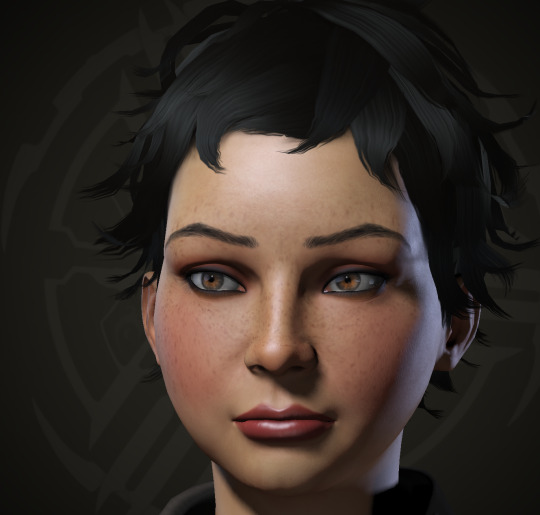
more
(I made her hair too dark, meh)
Pros: Face scupting is done with the mouse, pulling the face around. Fair amount of skintone and hairoptions, aging work well. Nice makeup. Free to play (game play has restrictions, but not the CC). Once done with tutorial, space station has ‘photobooth’ where you can make expressions and change lightning/background. Cons: The starting faction/race defines a lot of the variety, so you have to go back and forth - it’s hard to change the lips. Eyes were strangely hard to get brown, even when selecting brown. Only some factions have certain hairstyles. No fantasy races. Lips generally look odd on everyone.
Black Desert Online (Xbox One)

more
Pros: Very cutesy, face sculpting should give lots of options. Free with xbox gamepass, only $10 on PC for basic version. Some hair options. Cons: Class determines race and to some extent faces. Options when sculpting are not easily understood, and don’t work will on Xbox. I spend quite a bit of time on this, and I didn’t like the outcome at all. Style is cutesy (yes both pro and con, depending). Didn’t seem like there was a lot of skintone variety.
Final Fantasy XV Comrades (Xbox One)

more
Pros: High quality rendering. Free with gamepass. Cons: Very limited options, from everything to facial structure to skin color to hairstyles. Could not get her to look like Raina at all.
Mass Effect Andromeda (Xbox One)

more
Pros: Nice presets and changes are easy to work with. Fair amount of options and sliders for changing face. Fantasy hair colors, nice makeup for the most part. Lip options nice. High quality rendering. Cons: Not too many nose changes possible. Hard to make brown eyes due to color wheel. Eyebrows and complexion goes together. Not sure what the price is; not free. Not too many hair options (no curly hair really)
Picrew! This one is DJARN’s, but there are many

Pros: You can usually find various ones with good options, many cute ways to express character, free Cons: Very bound, need to find the right one. Not really useful as a ref as it’s indicative of the style of the artist who made the picrew.
Conclusion
There are many options out there if you want to avoid face claims. I’m surprised how enjoyable EVE was to use, especially since its a game about spaceships. I was also surprised how well DAI’s CC held up - I think if I had it on PC and had access to hair mods, it might be my preferred one?
In the end, I like her best in MEA, or EVE.
Funny Picrew comes closes to her hair. Non one has curly/wavy hair?
I didn’t try Baldur’s Gate 3, which should be really nice. I’m not sure I’m going to play the game, and it’s a little too much for a CC only. Maybe.
10 notes
·
View notes
Note
What tyepes and how elves do you have in your homebrew d&d??! Like the worldbuilding is huge, and hope I don't bother you by asking.
I don’t mind the questions, honestly! But be ready for an INCREDIBLY long read because I love elves and I might as well go into detail with them, and most of the information and brain thoughts can be found under the read more!
Anyway, I have 3 different realms. Manala, which is my Homebrew D&D world, The “It’s an Odd Kind of Fairytale Universe” which... is my webcomic’s universe (I still haven’t named the realm OTL) and Ozarathan, which is the Elf Only Universe.
Manala is the one I’ll focus on since you asked D&D homebrew but I’ll touch on the other two as well. Ozarathan’s elf types are a mix between the Manala and IAOKOFT elves but with SOME differences.
Now... onto my D&D elves!
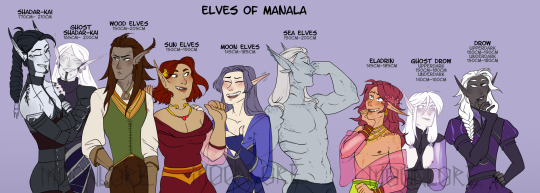
Manala has 10 types of elves. Here, we have 9 pictured, and those are the actual playable races. I’ll get to the last ones once I’ve explained these ones!
Manala has 2 categories of elves. True Elves and False Elves. False Elves are Wood Elves and Sea Elves, the rest are all True Elves. The reason for this categorization is that Wood Elves came to be when Eladrin mixed with Amali (beastfolk, essentially kemonomimi) and Sea Elves came to be when Eladrin mixed with Triton. They have plenty of elven blood, but they’re removed enough that they have their own cultures and are not as afflicted by The Hunt as True Elves are.
The Hunt is something all True Elves suffer from and it’s an innate bloodthirst. Elves on Manala are incredibly unhinged, especially Eladrin and Shadar Kai, who were the first Elves to be created onto Manala, and Shadar Kai especially just tend to start eating prey while it’s still alive. The others at least have the decency to kill the thing before starting to eat it. Most elves enjoy raw meat, and if it’s still warm from the hunt that’s even better.
That being said, High Elves (so Sun Elves, Moon Elves and Drow) try to move away from being so overcome by the Hunt that they immerse themselves into practising the arts, and most modern High Elves don’t even experience the Hunt anymore... unless they actually go out to hunt. Which they don’t, because they either raise livestock or assign certain individuals to hunt so that not everyone turns into chaotic bloodthirsty morons. Sea Elves have no remnants of The Hunt, and Wood Elves experience it in a completely different way. They don’t revel in the kill, they revel in the hunt itself and a hunting party can spend weeks away from home tracking down some kind of behemoth, running it ragged until it dies from stress.
True Elves also have mostly matriarchal societies, and most men dress in very revealing ways. Piercings and Tattoos are common across all True Elves, and preference of Fabric depends on region and subrace, with High Elves and Eladrin enjoying silken and loose flowing fabrics that move well, and Shadar Kai preferring leathers and wool to fight away the harsh cold of the Shadowfell.
Now... onto more specific explanations of the races!
Shadar Kai. Shadar Kai are one of the two Original Races of Elves. They were created alongside Eladrin, and at first were put into the Material Plane before the Creators decided to split the Material plane into 3, which resulted in the creation of the Shadowfell and Feywilds. Shadar Kai are definitely the most unpredictable of the elves, The Hunt is incredibly strong in them, and as such they get very distracted by that need to go out and kill some poor beast. Because of this, the Shadowfell is relatively safe where Elven societies exist, pretty much anything that’s deemed a danger is ripped apart. Their Shadowfell sister-race, the Shadow Orcs, keep them at an arm’s distance, but even if there’s surface bickering, but the two races are very close and if a larger enemy comes, the two team up and their combined forces easily dispatch any dangers.

Shadar Kai are the largest of all the elves. Stronger, more ferocious, and definitely way more extreme. Their society employs very Art Deco styles, unlike the other Elves who prefer the more fluid Art Nouveau looking styles. Shadar Kai have tons of piercings, and as they come of age, they get large geometric tattoos that cover their entire bodies to separate the youngins from adults. Shadar Kai do not have very colourful natural colours. Their eyecolour ranges from all tones from white to black, and occasionally very pale colours of any kind. Their Sclera tends to range from grey to black. Skintones range from black to white, and this is true for their hair too. The exception is with Ghost Shadar Kai, who are born pure white except for their sclera, and the result is a very jarring humanoid. They have feathery growths adorning their skin, mostly on the face, but down the back, on the shoulders and neck, as well as forearms is also common.
Up next are the Eladrin, who are really crazy and obviously very very horny because they ended up creating the false elves all on their own. They’re native to the Feywild, but very often travel to the Material Plane, so Eladrin are much more common than Shadar Kai. Like their Shadowfell counterparts, they have growths as well, but it ranges wildly from individual to individual, and even their season.

Eladrin can be pretty much any colour, and often have skin markings. They’re a colourful bunch. Eladrin men tend to be VERY ostentatious, and the less actually properly covering their skin, the better. But don’t let the bright colours, horniness and smaller size distract you, because the Eladrin are only marginally better than Shadar Kai when it comes to dealing with the Hunt. They’re a bunch of party animals but will definitely rip your throat out if they feel threatened.
Surface High Elves are the best at taking care of their Hunt instinct, and actually have it so under wraps that they have extensive cities filled with so much art of all kind that they make other races forget that Elves are actually nuts. Surface High Elves developed after certain clans of Eladrins began losing their connections to the Feywild after spending extensive amounts of time on the Material Plane.
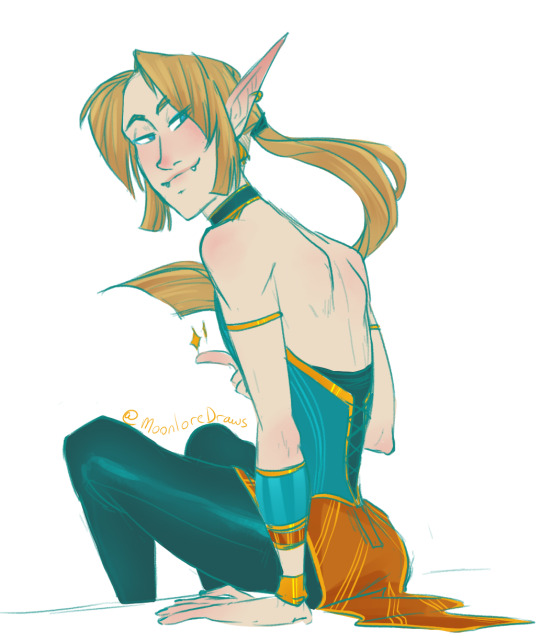
(Elerath isn’t a Sun Elf but he presents himself as such)
The men dress a LITTLE more sensibly, but the sheer variety of High Elf fashion can lead to some... weird clothing choices. Surface High Elves don’t have the jewel tone range of their Eladrin cousins, but still come in all kinds of skintones, hair colours and eye colours. They do not have any growths of any kind, and actually have super soft skin! (poking elf cheeks is super satisfying) The main difference between Sun and Moon Elves is mostly their colour schemes and sleep cycles. Sun Elves are diurnal, Moon elves are nocturnal.
Drow developed from an offshoot of Surface High Elves when they travelled into the Underdark to protect the Surface from Aberrations that had started migrating to the surface and causing chaos. Unlike canon Drow, Drow on Manala are not as bad with their overwhelming misandry and the whole “treating men like garbage” thing doesn’t exist. They’re still strongly matriarchal, and men are held to a different standard, but in a completely different way. Drow men are THE most beautiful group of elves in the entire world, and most high ranking ladies have harems of handsome men who they protect with such overwhelming ferocity that it almost rivals that of Shadar Kai. So I guess Drow men still get the short end of the stick but hey, at least they get pampered?? (But if you’re a handsome man, your chances of getting out into the world is... almost nil)

The Drow are zealous worshipers of The Spider, the Archfey of Weaving, Protection and Good Fortune, and due to this, they work in tandem with various Drider, who in this setting are natural Fey creatures, not drow dudes who fucked up a weird and complicated ritual. (Can you tell that I hate canon Drow culture? Because I really do. Drow have such great potential so here I am, turning things on its head)
Drow skintones range from white to charcoal, and sometimes have a slight purple tone. Eye colours tend to be jewel tones, but yellows, oranges and greens are very uncommon. Hair ranges from white to black, but can also be bright purple. The exception is with ghost drow, who are pure white. Even their pupils are difficult to distinguish from their iris so they look super jarring.
Wood Elves are a fun bunch. They don’t mingle with other elves as much, not do they associate with Amali much, but they have good relations with both. Most Wood Elf cities are hidden from the world at large since they tend to just keep to themselves and protect nature from other races, and to protect the other races from whatever lurks in the forest.

They have ears with extra lobes attached, and many also have fur on the tips and the back of the ears. Some individuals even have furry manes that run down their spines! Their colours are basically any shade of brown you can imagine. They span the entire human gamut, also include greys, and sometimes are a little too yellow or red toned to be completely right. They also sometimes have stripes or spots on their skins!
Then there’s the Sea Elves! Unlike other elves, Sea Elves are not mammalian. They lack breasts, and their young can eat fish pretty much as soon as they’re born. Sea Elf Babies are born very small, but more developed and take a while longer to get to their adult sizes since Sea Elves are quite large when it comes to elves. They have patches of scales on their skin, and gills. They can breathe both above and underwater, and most large Sea Elf societies are underwater, built into cliffs by the coast
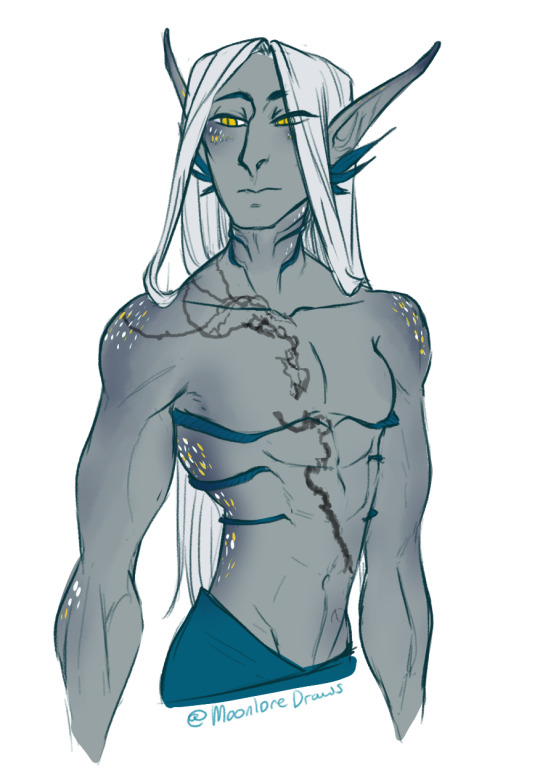
Any colour a fish is, they can be. As such, Sea Elves are seen as very striking individuals if they come from more tropical seas, and they become very sought after courtesans.
Elves in general are really horny. Unlike most media where elves are seen as aloof and standoffish and holier-than-thou because of their beauty and long lifespans, on Manala, ALL elf subraces are pretty easy to seduce. They enjoy the attention, and as a result, the entire realm is filled with half-elves of ALL kinds of mixtures. Also, gender is so fluid in elven society. An Elf picks how they present themselves and because of the ease at which magic is available, they can sculpt their bodies to fit how they wish to be seen. Elves said Trans Rights.
Now... there’s one type of elf I didn’t touch on, and those are the Aetherians. The Aetherians don’t play much of a role on Manala because they’ve actually left. Aetherians are essentially Space Elves and they have WEIRD crazy powers. They’re the creators of the realm, but after they deemed their newest project complete enough, they left. Well. Most of them did. Two of them remain in the Realm but I’m not going to reveal their identities.
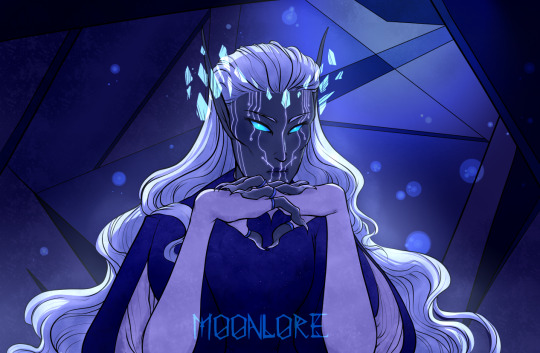
Aetherians are HUGE. They’re like. 9-10 feet tall, and have geometric grooves in their skin that glow. They also have floating crowns of shards above their heads. They’re a mystery, and were involved in the creation of the world, but aside from that almost nothing is known of them.
So uhhh yeah. Those are my D&D elves.
I’ll add a little bonus section of the Ozarathan Elves here as well because that’s fun:
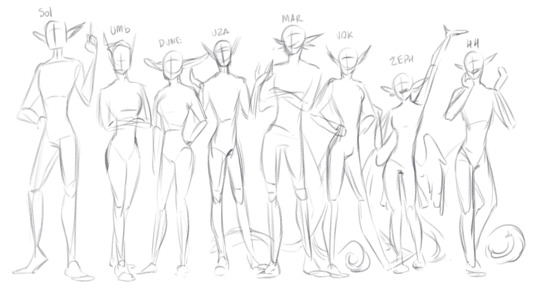
I haven’t finished drawing the lineup so the anatomy is whack on some of these here’s a general idea of their sizes??
(Also in IAOKOFT) The Solarians – slightly scorched skin, tanned, warm grey/brownish sclera, live in high mountains, art deco style, very isolationist.
(Also in IAOKOFT) The Umbrals - Reskinned Manala Shadar Kai and Ghost Shadar Kai, cousins to Umbrals, very similar aesthetics
The Vokorians- Reskinned Manala Wood Elves. They have the same fluffy ears but also have tails.
The Hush-Hush – Reskinned Manala Drow and Ghost Drow, but also have tails.
The Maritimians- Scaled Skin in parts, fins and gills, often have tails. Freshwater and Saltwater varieties exist.
(Also in IAOKOFT) The Zephyrians- Elves with small wings. Often have feathering on their bodies, and also have feathered tails. Live in moving cities that get moved by the wind. Nomadic.
(Also in IAOKOFT) The Uzarians- High Elves, the most typical elves.
(Also in IAOKOFT) The Duneriders- Desert elves. Grey sclera, dark skin, have marks, offshoot of Solarians, but have rounded highly mobile ears.
#D&D#Elves#Homebrew D&D#The World of Malana#The World of Ozarathan#Enjoy this GIANT MASTERPOST OF ELVES!!!
86 notes
·
View notes
Text
The Different Elves of Manala
I’ve been creating a homebrew D&D setting for ages and now I finally have some Good Good art of the different types of elves there are!

Eladrin are the Original Elves, that came over from the Feywilds! Highly mobile ears, and they usually grow a type of symbiotic moss that matches the season they’re in. Skin colour is mostly in human tones, as well as bright jewel tones. Dark and muted tones are rare, but possible. The moss can grow pretty much anywhere but mostly grows in their hair, along cheekbones and jaws, on shoulders, arms and the backs of hands, as well as along the spine.

Shadar-Kai are Eladrin who decided to move to the Shadowfell. Similar to their Eladrin cousins, Shadar-Kai have growths along certain parts of their bodies, though these seem more akin to feathers or scales, even fur in some cases, rather than moss. Their skin and hair colours range from pale ivory to charcoal black, and the shades of grey between. Eyes are contrasting, with either white sclera and dark irises or the opposite. Grey sclera also appears, in which case their eyes can be of any muted colour. In the Shadowfell it is hard to see colour, but Shadar-Kai in the material plane have an iridescent quality to their hair, eyes and accent growths.


High Elves on Manala are descended from Eladrin, though have lost much of the strangeness of their Feywild cousins. Their skin is smooth, ranging through the human tones, as well as greys, and other lighter muted tones except for greens and purples, though much of how they look depends if they fall under the Moon or Sun Elf category. Hair colour can be anything as dyeing through magic has become popular to achieve the perfect aesthetic. High Elves, like their extraplanar cousins, are mostly Matriarchal, and men usually dress in a way that is seen as quite outrageously skimpy by other races, just to catch the eyes of their chosen Love Interests.

Drow are incredibly similar to High Elves, having developed at the same time as their surface dwelling cousins. Their skin colours range from pale ivory to charcoal black, though also dip into purples. Eye colours range mostly in the jewel tones. Hair colour also varies from white to black, with everything in between on the grey scale. Dyeing hair has not become popular within drow populations. Drow Matriarchal societies are quite extreme, and men are almost exclusively only given the roles of concubines, with very few men ever having the chance to follow the careers of Mages or Warriors through. If you thought the other elf men dressed skimpy, drow men are hands down the sexiest of the bunch, sheer fabric is VERY common and they leave little to the imagination.


Wood Elves are the children of unions between Amali and other Elves, and soon became their own thing. Wood Elf skintones range along different creams, browns and greys, sometimes going into warmer oranges and copper hues. Hair colour tends to keep to those similar natural tones, though occasionally dip into slightly green and yellow tones. Eye colours avoid colder jewel tones like blues and purples and many reds, though greens, yellows and oranges are common.
Wood elves have little nubs growing on their ears, and many have fur on the tips and backs of the ears. Certain individuals even have hair growing along their spines. Unlike other elves, wood elf men dress less outrageously.

Sea Elves were born of the union between elves and tritons. Culturally the least elven, sea elves live in mostly coastal societies and shallow water cities. Any colour a fish can come in, they come in. They lack breasts, as they’re more fish than mammal, and many individuals are even cold blooded. The fins that grow along their ears differ depending on individual, and many fin shapes are common. They also have scales dotted across their bodies, though these do not offer any protection.
Elves on Manala are very complex, with many cities and houses having their own traditions and rules. As a whole, they’re matriarchal, but there are always exceptions. They also view gender in a way that is much more complex than other races, with a variety of trans, non-binary, genderfluid and agender identities, which, given their long lifespans and obsession with introspection and finding the perfect self, makes sense.
#Long Post#Elves#The World of Manala#D&D Homebrew#One day I'll draw some proper pages of elf intros so you can all see the different fashions of all the different types of elves
44 notes
·
View notes